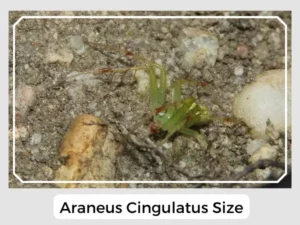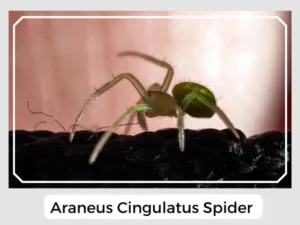The Araneus cingulatus is a special kind of orb weaver spider. What makes it stand out? It has bright red spots on its tummy! If you’re curious about this red spotted spider, we’ve got some fun facts to share.

Photo Credit: Ben Springer
The eggs are generally laid in a sac by the female spiders.
Spiderlings are yellow, ballooning off with the help of a silk thread once mature enough.
The wheel-shaped webs are often observed high on trees, either on leaves or between branches.
Yes, Araneus cingulatus spiders have venom. They use it mainly to help them catch their meals.
They can bite, but they’re often just minding their own business. If they feel threatened, they might bite to defend themselves. Their bite is not deadly to humans.

Photo Credit: Chuck Sutherland
Araneus cingulatus spiders are important players in their ecosystems. As predators, they help control the populations of insects, thus contributing to the balance of nature and the health of forests.
Natural Predators: Birds, larger insects, and small mammals are common predators of the Araneus cingulatus, keeping their populations in check.
Prey-Predator Dynamics: This spider uses its venom to immobilize prey caught in its web, playing a crucial role in the food web by managing the insect population and preventing overpopulation of certain species.
Relationship with Humans: Araneus cingulatus spiders maintain a low profile around humans, posing no significant threat. Their bite is rare and, while it may cause discomfort, it is not harmful to people.
| Lifespan | Around 1 year |
| Distribution | The United States |
| Habitat | Forests |
| Diet | Insects |
In summary, the Araneus cingulatus spider is an example of nature’s intricacy and diversity. Its presence in forests is a testament to the complex web of life where each species, regardless of size, has a role to play.
The Araneus cingulatus is a special kind of orb weaver spider. What makes it stand out? It has bright red spots on its tummy! If you’re curious about this red spotted spider, we’ve got some fun facts to share.

Photo Credit: Ben Springer
The eggs are generally laid in a sac by the female spiders.
Spiderlings are yellow, ballooning off with the help of a silk thread once mature enough.
The wheel-shaped webs are often observed high on trees, either on leaves or between branches.
Yes, Araneus cingulatus spiders have venom. They use it mainly to help them catch their meals.
They can bite, but they’re often just minding their own business. If they feel threatened, they might bite to defend themselves. Their bite is not deadly to humans.

Photo Credit: Chuck Sutherland
Araneus cingulatus spiders are important players in their ecosystems. As predators, they help control the populations of insects, thus contributing to the balance of nature and the health of forests.
Natural Predators: Birds, larger insects, and small mammals are common predators of the Araneus cingulatus, keeping their populations in check.
Prey-Predator Dynamics: This spider uses its venom to immobilize prey caught in its web, playing a crucial role in the food web by managing the insect population and preventing overpopulation of certain species.
Relationship with Humans: Araneus cingulatus spiders maintain a low profile around humans, posing no significant threat. Their bite is rare and, while it may cause discomfort, it is not harmful to people.
| Lifespan | Around 1 year |
| Distribution | The United States |
| Habitat | Forests |
| Diet | Insects |
In summary, the Araneus cingulatus spider is an example of nature’s intricacy and diversity. Its presence in forests is a testament to the complex web of life where each species, regardless of size, has a role to play.